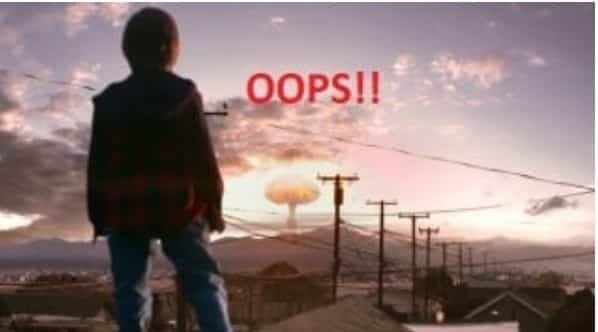

Helping America Die “Well Informed”
—
By Gordon Duff, Senior Editor and Jeff Smith
———————- Under Bill Richardson’s watch at DOE………………
An apathetic approach towards reducing the inherent dangers of plutonium stored in unsafe and highly unstable forms;
Incompetence bordering on negligence in caring for more than 12,000 plutonium pits;
- Secretly developing new capabilities for plutonium pit production while touting dual-use plutonium processing facilities as “nonproliferation missions;”
While DOE has continued to declassify information and more information is available than ever, this is not the true mark of openness. Openness and honesty is characterized by up-front revelations about the real hazards, uncertainties, and economics of new projects; and not by facades of unwarranted optimism and a flippant disregard for the public trust.
When people are engaged in a process like Environmental Impact Statements that lead to a Record of Decision signed by top-level officials, they have an expectation that a small group of bureaucrats will discard the decision at the earliest convenience. Nowhere is this more true than in the plutonium program, where DOE has made numerous claims during the public debate that are contradicted by internal memos, obscure reports, and even public documents available on various Departmental Internet sites.
One fact that has become increasingly clear is that the plutonium hazard has more depth and breadth. Not only is plutonium useable in nuclear weapons at the scale of kilograms and acutely toxic at the scale of milligrams, it is also has the most complex chemistry in the Periodic Table of the Elements DOE officials who have told the public countless times that alpha radiation can be blocked by a piece of paper have failed to inform people that alpha radiation from the decay of plutonium 239 causes, over the course of decades to centuries, damage to plutonium metal, any metal in contact or near contact with plutonium, and adverse chemical reactions with our most common elements, oxygen and hydrogen.
All these things also make keeping track of plutonium much more difficult.
If the alpha particles from the decay of plutonium 239 can damage the densest metal on earth, the impacts of alpha radiation from plutonium ingested or inhaled in the human body is obviously detrimental. Plutonium is often said to be “harmless” if ingested as a metal, but this is an obvious fallacy since it turns out that plutonium metal has a microscopic layer of plutonium oxide present at all times. The chemical reactions with common materials that worry metallurgists and weapons designers are certainly a concern inside the human body.
Plutonium is most hazardous in an oxide powder form, with inhalation of only 20 milligrams enough to kill someone quickly and 30 to 60 micrograms easily enough to greatly raise the risk of cancer. Yet, DOE is planning to truck 3 metric tonnes of plutonium oxide from Rocky Flats to Savannah River Site this year in its politically motivated rush to close Rocky Flats as soon as possible.
Although the revelations about plutonium complexity has forced DOE to finally establish a long term plutonium storage standard, it is pursuing projects at odds with its own standards. The best example is DOE’s zealous pursuit of a plutonium MOX fuel factory that utilizes surplus weapon-grade plutonium found in plutonium pits.
To make this fuel requires nitric acid based plutonium processing that has generated tremendous radioactive waste problems in the past, a process that greatly increases the likelihood of explosions, spills, and accidental criticality. Yet, the plutonium storage standard requires plutonium oxide to be heated to temperatures that make nitric acid processing even more dangerous. (Page 1.7). Instead of recognizing that plutonium fuel production from weapons plutonium is incompatible with its own storage standard, DOE seems intent on neglecting its commitment to safe storage in favor of its devotion to plutonium fuel.
In the past five years, DOE has reneged on nearly every one of its plutonium management decisions (see sidebar on Page iii) that did not involve spreading the liability at Rocky Flats around the country as quickly as possible or pursuing the dream of stuffing aging nuclear reactors one-third full of plutonium fuel. While underfunding the most fundamental mission-safe and secure storage-it has spent millions of dollars on unnecessary projects like gallium removal experiments and an irrelevant MOX fuel test in Canada.
DOE has not released updated plutonium inventory figures in five years and has even silently carved away bits and pieces of the declared surplus:
—In November 1999, DOE removed 3.8 (MT) of surplus plutonium found in unirradiated nuclear fuel in Idaho which forced the planning team for the plutonium immobilization plant at SRS to issue its third design; and another 0.6 to 0.8 MT of unirradiated nuclear fuel at Hanford was removed for “possible programmatic use.”
—In 1998 an undisclosed number of surplus plutonium pits were recategorized as “national security assets;”
—In 1998 the nuclear weapons program at Los Alamos received “permission from the politicians” to divert some “nickel-sized” pieces of plutonium from its pit disassembly and conversion demonstration project for plutonium aging studies in support of nuclear weapons stockpile stewardship;
DOE matched this failure to be up-front with its numbers with an aversion to being up-front about the hazards of its proposals. During the Surplus Plutonium Disposition Environmental Impact Statement process, DOE attempted to hide the fact that plutonium pit disassembly and conversion involved tritium and beryllium processing that would have meant a 10,000 fold increase in radioactive air pollutants at Pantex and will mean that SRS will become a certifiable beryllium site.
| In 1997 DOE canceled its effort to repackage 12,000 plutonium pits in “state-of-the-art” AT-400A shipping and storage containers at Pantex. After spending $50 million on research and development, the plug was pulled after a mere 20 plutonium pits were repackaged. |
| In December 1997 DOE abandoned its efforts to upgrade Building 12-66 at Pantex for surplus plutonium pit storage after completing the preconceptual design work. |
| In 1999 DOE abruptly canceled construction of a new plutonium storage and stabilization facility at Savannah River Site after spending $70 million on its design and nearly completing excavation work. Two years later, DOE still does not have a long- term storage plan for non-pit plutonium at SRS, but still plans to truck about 9 metric tonnes from Rocky Flats to SRS. |
| In fiscal year 2000 DOE quietly stopped funding the plutonium pit reuse project at Pantex, a program designed to avoid costly and environmentally damaging plutonium pit fabrication. |
| In 1997 DOE ceased plutonium stabilization efforts at Los Alamos in favor of pursuing the ARIES project, which has turned out to be an essential pre-cursor to plutonium pit production. |
| In 1999 DOE began shipping plutonium residues called “sands, slags, and crucibles” from Rocky Flats to SRS, then abruptly quit and decided to send the material to WIPP. |
Higher on the list was DOE’s selection of a nitric-acid based plutonium conversion process for making Mixed Oxide (MOX) plutonium fuel in 1997. Unfortunately, DOE did not inform the public of its decision until late in 1999 and then grossly underestimated the impacts of the operations.
But the most egregious example of dishonesty was the public presentation of plutonium disposition facilities as nonproliferation missions while DOE officials, at the urging of the Pentagon and Congress, secretly crafted a parallel plan to produce new plutonium warheads. The possibility of SRS dismantling plutonium pits for a few years and then putting new ones together is very real.
The list includes internal stonewalling, drastic funding cuts on fundamental programs, constant redesign and “rebaselining,” and a plethora of contradictions:
- In spite of repeated requests, the National Laboratories have not provided Pantex with a list of plutonium pits called “National Security Assets” in nearly two years. The labs’ inabilities to provide consistent storage criteria has contributed to the unease about plutonium pit conditions.
- After five years of inventory and the introduction of new technologies, DOE still cannot say whether or not it still has 2.8 metric tonnes of unaccounted-for plutonium;
- While the Office of Fissile Materials Disposition tells the country that it must accept the plutonium fuel option because Russia will not accept the U.S. burying its weapons-grade plutonium, the Office of Environmental Management keeps proposing to bury more plutonium residues containing weapon-grade plutonium in the Waste Isolation Pilot Plant in New Mexico
- During five years of Environmental Impact Statements, DOE never informed the public that declassification of pits included declassifying the isotopic composition. One month after the January 2000 Record of Decision to build a PDCF at SRS was signed, the “blending” of plutonium oxides from two or more pit types was required to declassify the isotopic composition of the powder, adding yet another complication to an already confusing program.
- The plutonium pit program continues to languish from a lack of funding, as DOE refuses to honor its commitments to repackage the pits at a rate of 200 per month, insure that “dirty” pits are cleaned prior to storage, procure thousands of new containers for its “national security assets,” decide on a facility storage plan, and design a shipping container.
1. There must be a renewed attitude towards increased openness and honesty in the U.S. nuclear weapons complex and a reversal of the current trend against openness.
2. DOE must publish its latest inventories of plutonium, uranium, and other special nuclear materials and disclose any information suggesting that diversion of materials has occurred. BREDL is making the following estimates based on DOE’s figures in various reports, showing the sheer volume of plutonium “items,” requiring individual handling at some point in time:
|
Plutonium Inventory |
| Plutonium Form |
# Items |
Plutonium Content, MT |
|
Non-Pit Plutonium Solutions |
43,000 Liters | 0.5 |
|
Metals |
6,361 |
8.6 |
|
Oxides |
12,537 |
6.35 |
|
Residues |
29,530 |
6.35 |
|
Unirradiated Fuel |
52,000 |
4.4 |
| Plutonium Pits |
20,000 |
66.1 |
| Irradiated Fuel |
7.5 |
|
| Total |
120,528 |
99.8 to 100.0 |
3. Insure that DOE lives up to its promises and commitments made in Environmental Impact Statements and in implementation Plans to the Defense Nuclear Facilities Safety Board.
4. Make safe and secure storage of plutonium the number one priority in the weapons complex.
5. Cease all efforts to pursue full-scale plutonium pit production and a plutonium fuel economy and focus on reducing the plutonium hazard.
6. The inherent chemical instability of plutonium should be an added incentive to make drastic cuts in the nuclear weapons arsenal.
ATTENTION READERS
We See The World From All Sides and Want YOU To Be Fully InformedIn fact, intentional disinformation is a disgraceful scourge in media today. So to assuage any possible errant incorrect information posted herein, we strongly encourage you to seek corroboration from other non-VT sources before forming an educated opinion.
About VT - Policies & Disclosures - Comment Policy



